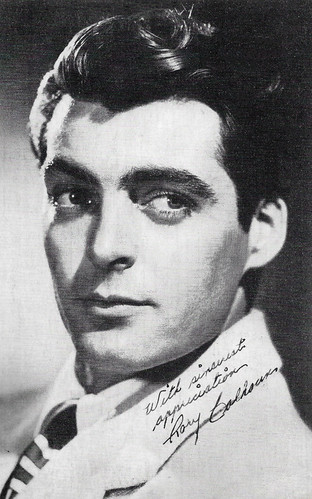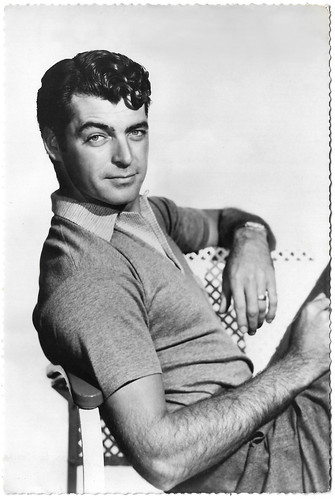
Italian postcard by Bromofoto, Milano. Photo: Universal International.

British postcard in the Greetings series, no. A.Photo: 20th Century Fox.

British postcard in the Picturegoer Series, London, no. S.53. Photo: R.K.O. Radio.
His young criminal career was rather extensive
Rory Calhoun was born Francis Timothy McCown in 1922 in Los Angeles, California. His father was James 'Floyd' McCown, a professional gambler, and his mother was Elizabeth Cuthbert. When he was nine months old his father died. After his mother remarried he occasionally used the last name of his stepfather, Durgin.
His young criminal career was rather extensive. A high school dropout, he stole a revolver at age 13, which landed him in the California Youth Authority's Preston School of Industry reformatory at Ione, CA. He escaped while in the adjustment centre (jail within the jail). He left home at 17 to escape beatings from his stepfather and began hot-wiring cars. After robbing several jewellery stores, he stole a car and drove it across state lines. This offence sent him to the federal penitentiary in Springfield, MO, for three years. When he finished his sentence he was incarcerated in San Quentin State Penitentiary in California on other charges and remained there until he was paroled just before his 21st birthday. Before becoming an actor he worked as a boxer, a lumberjack, a truck driver and a cowpuncher.
His life changed when a Hollywood agent, Sue Carol, auditioned him at 20th Century Fox. He was noticed by Alan Ladd, Sue's husband when Rory was riding a horse in a Los Angeles park. Impressed with Calhoun's physique, Ladd introduced him to Sue. Rory got a bit role in Something for the Boys (Lewis Seiler, 1944), with Carmen Miranda. He got his first credited role as Frank McCown in the Laurel and Hardy comedy, The Bullfighters (Malcolm St. Clair, 1945). He was signed to a contract by Henry Wilson, an agent known for a stable of young and attractive actors with unusual names like Rock Hudson and Tab Hunter. He initially christened him "Troy Donahue", then changed it to "Rory Calhoun". Wilson used the Troy Donahue name later on another up-and-coming actor. Wilson was an employee of David O. Selznick and he signed Calhoun in Selznick's company.
His first public appearance was as Lana Turner's escort to the premiere of Alfred Hitchcock's Spellbound (1945), a Selznick production. The glamorous blonde and her handsome companion attracted the paparazzi, and photos appeared in newspapers and fan magazines. In 1945, he was sent again to prison for beating a detective. Calhoun did not appear in a film for a year before being lent to producer Sol Lesser for the thriller The Red House (Delmer Daves, 1947) with Edward G. Robinson. In the same year, he worked in two more films, Adventure Island (Sam Newfield, 1947) and That Hagen Girl (Peter Godfrey, 1947) starring Shirley Temple. He graduated to starring in Westerns such as Sand (Louis King, 1949). He first appeared in a negative role in Return of Frontiersman (Richard L. Bare, 1950), starring Gordon MacRae and Julie London.
In August 1950, Rory Calhoun signed a seven-year contract with 20th Century Fox. Some of his first films for Fox were such Westerns as A Ticket to Tomahawk (Richard Sale, 1950), and Rogue River (John Rawlins, 1951). With Susan Hayward, he co-starred in the musical With a Song in My Heart (Walter Lang, 1952) and with Gene Tierney in the Western Way of a Gaucho (Jacques Tourneur, 1952). Calhoun co-starred with Marilyn Monroe in the comedy How to Marry a Millionaire (Jean Negulesco, 1953) as Betty Grable's love interest and the Western River of No Return (Otto Preminger, Jean Negulesco, 1954), starring Robert Mitchum. Both films were big hits. Calhoun then left Fox. He starred in such Westerns as The Yellow Tomahawk (Lesley Selander, 1954), A Bullet is Waiting (John Farrow, 1954) and The Spoilers (Jesse Hibbs, 1955) with Ann Baxter.

British postcard in the Filmgoer Series, London, no. W 849. Photo: David O. Selznick.

American postcard by Vanguard Studio, Culver City, California, sent by mail in 1949.

British postcard in the Picturegoer Series, London, no. D 567. Photo: David O. Selznick.
His mugshot on the cover of Confidential magazine
Rory Calhoun's conviction history became public when his mugshot appeared on the May 1955 cover of Confidential magazine. According to one source, his agent, Henry Willson, disclosed information about Calhoun's years in prison to Confidential in exchange for the tabloid not printing an exposé about the secret homosexual life of Rock Hudson, another Willson client. According to another source, blackmailers threatened to make his prison record public, so instead, Calhoun revealed it himself. However, the disclosure had no negative effect on Calhoun's career and only served to solidify his 'bad boy' image.
He starred in such Westerns as Raw Edge (John Sherwood, 1956), The Hired Gun (Ray Nazzaro, 1957) and Ride Out of Revenge (1958). In 1957, Rory and his partner Victor Orsatti started a film production company called 'Rorvic'. He helped produce films like the Film Noir Flight to Hong Kong (Joseph M. Newman, 1956), and the Westerns The Hired Gun (Ray Nazzaro, 1957), Domino Kid (Ray Nazzaro, 1957), and Apache Territory (Ray Nazzaro, 1958). In 1959, he made his television debut in The Texan (1959-1960). Around this time, Rory also started scriptwriting. He also appeared in an episode of the CBS show December Bride (1959). The episode was called 'Rory Calhoun the Texan'.
In the early 1960s, Rory Calhoun starred in the stock car racing film Thunder in Carolina (Paul Helmick, 1960), and the Peplum Il Colosso di Rodi/The Colossus of Rhodes (1961), co-written and directed by Sergio Leone. The film was Leone's first work as a credited director, in a genre where he already had worked before as the replacement director for The Last Days of Pompeii and as a secondary director for both Ben-Hur and Quo Vadis. The film was originally meant to star John Derek. However, he clashed with Sergio Leone and was replaced by Rory Calhoun. Calhoun travelled to Spain to make the film, then to Great Britain for The Treasure of Monte Cristo (Monty Berman, Robert S. Baker, 1961) in Britain, and then to Italy for L'avventura di un italiano in Cina/Marco Polo (Piero Pierotti, 1962) with Yoko Tani. He returned to the U.S. to make several films for producer A.C. Lyles, such as the war film The Young and the Brave (Francis D. Lyon, 1963) and the Western Apache Rising (R.G. Springsteen, 1965), with Corinne Calvet.
He returned to Europe to make the French Eurospy film Our Men in Bagdad (Paolo Bianchini, 1966) with Roger Hanin, and the Spanish adventure film The Emerald of Artatama (José María Elorrieta, 1969). During the 1960s, he also guest-starred in several popular TV shows like Death Valley Days (1963), Bonanza (1964), Gunsmoke (1965), I Spy (1966), Gilligan's Island (1967) and Custer (1969). In the 1970s he could be seen in TV shows such as The Doris Day Show (1972), Police Story (1973), Starsky and Hutch (1975) and Fantasy Land (1978). In 1982, he appeared for five years as Judge Judson Tyler on the US soap opera Capitol and remained on the show until it ended in 1987. In the cinema, he starred in cult films like the Science-Fiction horror film Night of the Lepus (William F. Claxton, 1972) with Janet Leigh, the comedy horror film Motel Hell (Kevin Connor, 1980), the exploitation horror film Angel (Robert Vincent O'Neill, 1984), and the Science-Fiction action film Hell Comes to Frogtown (Donald G. Jackson, R. J. Kizer, 1989). He produced himself Fists of Steel (Jerry Schafer, 1991). His last film as an actor was Pure Country (Christopher Cain, 1992) in which the still handsome Calhoun played the character of 'Earnest Tucker', a family patriarch and farmer. His last screen appearance was in the horror anthology television series Tales from the Crypt (1993).
Rory Calhoun was married three times, once to his first wife and twice to his second wife. His first wife was Lita Baron (1948-1970), with whom he had three daughters, Cindy (1957), Tami (1958) and Lorri (1961). At the time of the divorce, Baron accused him of committing adultery with more than 70 women, including Betty Grable. Reportedly, Calhoun responded, "Heck, she didn't even include half of them". His second wife was journalist Sue Rhodes (1971-1979; 1982-1999) with whom he had one daughter, Rory Patricia (1971). He also had a daughter with actress Vitina Marcus, Athena Marcus Calhoun, who became "The World's Most Beautiful Showgirl" and was awarded "The Key to the City of Las Vegas" in 1987. Guy Madison was one of his closest friends. The two men often went on fishing and hunting trips. Guy and his (second) wife Sheila Connolly named him godfather to their firstborn Bridget. Rory Calhoun passed away in 1999 at the age of 76 after a ten-day hospitalisation at Providence Saint Joseph Medical Center in Burbank, California. He died due to complications from emphysema and diabetes. Calhoun has two stars on Hollywood's Walk of Fame: one for motion pictures, and one for television.

Yugoslavian postcard by ZK, no. 3925.

Vintage postcard.

Italian postcard by Bromofoto, Milano, no. 1881. Photo: Dear Film.
Sources: Bill Takacs (IMDb), Celeb-true (Dutch), Wikipedia and IMDb.
No comments:
Post a Comment